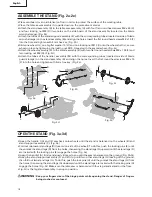
4
• Loosen two stop screws (A) on the extension poles (B) of
the outfeed support (C).
• Loosen the locking knobs (D) under the working table counter-
clockwise.
• Insert the rear extension table poles (B) into the two holes
in the rear of the work table and into the extension tube brackets
that are located under the work table. Position the outfeed
support.
• Thread the locking knobs (D) into the the holes under the work
table and tighten them.
• Thread the two stop screws (A) into the holes located on ends of
the extension poles (B) and tighten them.
OUTFEED SUPPORT ASSEMBLY INSTALLATION (Fig. 10a-10b)
RIP FENCE INSTALLATION (FIG. 11a-11c)
Fig. 10a
1
3
4
2
2
3
Fig. 10b
Fig. 11a
Fig. 11b
• Holding the fence (C) at an angle, align the position screws (front
and back) on fence rails with the fence slots (H).
• Slide the slots (H) onto the position screws and rotate the fence
down until it rests on the rails.
• Secure the rip fence in place by turning the rip fence locking
knobs (B) clockwise.
• Lock the fence rails lever (A).
• Push down the fence rails lever (A) toward the rear of the saw to
unlock it.
• Loosen the rip fence locking knobs (B) on the rip fence.
• Sliding the rip fence (C) to right and swing it up at an angle, then
remove the fence from the front and rear fence rails (D).
CAUTION:
There are three position screws (E, F, G) on the
each front and rear fence rails (D) to attach rip
fence. Position screws (E, F) use for rip fence on
the right of saw blade. Position screws (G) use for
rip fence on the left of saw blade. (Fig. 11b)
CAUTION:
The rip fence should be parallel to the saw blade.
If not, refer to the section “ALIGNING RIP FENCE
TO BLADE”.
CAUTION:
Three position screws apply to three different
scales:
Position screw AA: Begin with 0 to 27 in. end. (Rip
fence located on the right of the blade)
24
English
A
C
D
A
C
F
D
D
G
E
F
E
G
B
A
C
B
B
2
1
















































